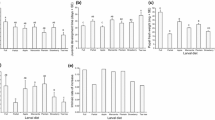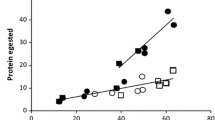Abstract
The food web centering on Allium ursinum (Liliaceae) in a beech forest (Germany) is described, and temporal variation of active trophic links is related to species' life cycles. The most important insect herbivores are Cheilosia fasciata (a larval leaf miner) and Portevinia maculata (a larva bulb miner) (Diptera: Syrphidae). Energy, carbon and nitrogen flow in the food chain (Allium-Cheilosia-Phygadeuon ursini) are investigated and analysed with respect to differences in resource allocation by the leaf miner and its hymenoptereous parasitoid. In C. fasciata nitrogen is likely to be the limiting resource, while growth in Phygadeuon ursini appears energy-limited. Larval feeding habits of C. fasciata and Portevinia maculata determined the timing of the species' life cycles and, as a consequence, appeared to preclude the existence of a pupal parasitoid in Portevinia maculata. Further details of life history traits are demonstrated and discussed.
Similar content being viewed by others
References
Berenbaum MR (1990) Coevolution between herbivorous insects and plants: tempo and orchestration. In: Gilbert F (ed) Insect life cycles-genetics, evolution and co-ordination. Springer, London, Berlin Heidelberg New York, pp 87–99
Bradford A, Hawkins BA, Askew RR Shaw MR (1990) Influences of host feeding-niche and foodplant type on generalist and specialist parasitoids. Ecol Entomol 15:275–280
Brown VK (1986) Life cycle strategies and plant succession. In: Taylor F, Karban R (eds) The evolution of insect life cycles. Springer, New York Berlin Heidelberg, pp 105–124
Cohen JE (1978) Food webs and niche space. Monographs in population biology 11. Princeton University, Princeton, NJ
Crawley MJ (1983) Herbivory. The dynamics of animal-plant interactions. Studies in ecology 10.Blackwell, Oxford
Dierschke H, Song Y (1982) Vegetationsgliederung und kleiinräumige Horizontalstruktur eines submontanen Kalkbuchenwaldes. In: Dierschke H (ed) Struktur und Dynamik von Wäldern. Berl Int Symp IVV Rinteln 1981. Cramer, Vaduz pp 513–539
Eggert A (1985) Zur Ökologie der Krautschichtvegetation in einem Bärlauch-Kalkbuchenwald. Doctoral thesis, Göttingen
Eggert A (1992) Dry matter economy and reproduction of a temperate forest spring geophyte, Allium ursinum. Ecography 15:45–55
Heatwole H (1989) The concept of the econe, a fundamental ecological unit. Trop Ecol 30:13–19
Herting B (1960) Biologie der westpaläarktischen Raupenfliegen-Dipt., Tachinidae. Monogr Angew Entomol 16:1–188
Hövemeyer K (1985) Die Zweiflügler (Diptera) eines Kalkbuchenwaldes: Lebenszyklen, Raum-Zeit-Muster und Nahrungsbiologie. Doctorall thesis, Göttingen
Hövemeyer K (1987a) The population dynamics of Cheilosia fasciata (Diptera, Syrphidae): significance of environmental factors and behavioural adaptation in a phytophagous insect. Oecologia 73:537–542
Hövemeyer K (1987b) Der Einfluß von Streumenge und Streuqualität auf die Siedlungsdiche von Dipterenlarven: ein Freilandexperiment im Kalkbuchenwald (Zur Funktion der Fauna in cinem Mullbodenwald 4). Verh Ges Ökol 17:229–236
Hövemeyer K (1992a) Population studies of Cheilosia fasciata (Diptera: Syrphidae), a leaf miner of Allium ursinum. Ecol Entomol 17:331–337
Hövemeyer (1992b) Die Dipterengemeinschaft eines Kalkbuchenwaldes: eine siebenjährige Untersuchung. Zool Jahrb Syst Oekol Geogr Tiere 119:225–260
Hövemeyer K (in press) Seasonal and diurnal activity patterns in the hoverfly Cheilosia fasciata (Diptera: Syrphidae). Entomol Gen 19
Humphreys WF (1979) Production and respiration in animal populations. J Anim Ecol 48:427–453
Janzen DH (1984) Two ways to be a tropical big moth: Santa Rosa saturniids and sphingids. Oxford Surv Evol Biol 1:85–139
Jeffries MJ, Lawton JH (1984) Enemy free space and the structure of ecological communities. Biol J Linn Soc 23:269–286
Judas M (1989) Populationsökologie der Regenwürmer (Lumbricidae) in einem Kalkbuchenwald: Abundanzdynamik und Bedeutung von Nahrungsressourcen. Ber Forschung Waldökosyst A 53:1–140
Kitching RL (1987) Spatial and temporal variation in food webs in water-filled treeholes. Oikos 48:280–288
Lawton JH (1989) Food webs. In: Cherret JM (ed) Ecological concepts. Blackwell, Oxford, pp 43–78
Lawton JH, Schroeder D (1977) Effects of plant type size of geographical range and taxonomic isolation in number of insect species associated with British plants. Nature 265:137–140
Nielson TR (1979) Hoverflies (Diptera, Syrphidae) associated with ramson, Allium ursinum L. Fauna Norv Ser B 26:21–23
Peck LV (1988) Family Syrphidae. In: Soos A, Papp L, (eds) Catalogue of palaerctic Diptera, vol 8. Elsevier, Amsterdam, pp 11–229
Polis G (1991) Complex trophic interactions in desert: an empirical critique of food-web theory. Am Nat 138:123–155
Reavey D, Lawton JH (1991) Larval contribution to fitness in leafeating insects. In: Bailey WJ, Ridsdill-Smith J (eds) Reproductive behaviour of insects. Chapman and Hall, London, pp 293–329
Rotheray GE (1988) Morphology and feeding behaviour of the leaf-mining larva of Cheilosia semifasciata (Diptera: Syrphidae). J Nat Hist 22:865–873
Sayer M (1984) Zur Populationsökologie und Nahrungsbiologie von Kleinsäugern eines Laubwaldes. Diploma thesis, Göttingen
Schaefer M (1990) The soil fauna of a beech forest on limestone: trophic structure and energy budget. Oecologia 82:128–136
Schoenly K, Beaver RA, Heumier TA (1991) On the trophic relations of insects: a food-web approach. Am Nat 137:597–638
Shaw MR, Askew RR (1978) Hymenopterous parasites of Diptera (Hymenoptera Parasitica). In: Stubbs A, Chandler P (eds) A Dipterist's handbook. The Amateur Entomologists' Society, Hanworth, pp 164–171
Southwood TRE (1978) Ecological methods. Chapman and Hall, London
Speight MCD (1986) Portevinia maculata (Fal.): last instar larva and puparium, with notes on the relationship between this hoverfly and its larval host plant, Allium ursinum (Diptera, Syrphidae). Nouv Rev Entomol3: 37–43
Ssymank A, Gilbert F (1993) Anemophilous pollen in the diet of Syrphid flies with special reference to the leaf feeding strategy occurring in Xylotini (Diptera, Syrphidae). Dtsch Entomol Z 40:245–258
Stinner BR, Abrahamson WG (1979) Energetics of the Solidago canadensis-stem gall insect-parasitoid guild interaction. Ecology 60:918–926
Tauber MJ, Tauber CA, Masaki S (1986) Seasonal adaptations of insects. Oxford University Press, New York
Warren PH (1989) Spatial and temporal variation in the structure of a freshwater food web. Oikos 55:299–311
White TCR (1993) The inadequate environment-nitrogen and the abundance of animals. Springer, Berlin Heidelberg New York
Wiegert RG, Petersen CE (1983) Energy transfer in insects. Annu Rev Entomol 28:455–486
Wilbur HM (1980) Complex life cycles. Annu Rev Ecol Syst 11:67–93
Author information
Authors and Affiliations
Rights and permissions
About this article
Cite this article
Hövemeyer, K. Trophic links, nutrient fluxes, and natural history in the Allium ursinum food web, with particular reference to life history traits of two hoverfly herbivores (Diptera: Syrphidae). Oecologia 102, 86–94 (1995). https://doi.org/10.1007/BF00333314
Received:
Accepted:
Issue Date:
DOI: https://doi.org/10.1007/BF00333314




